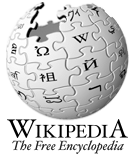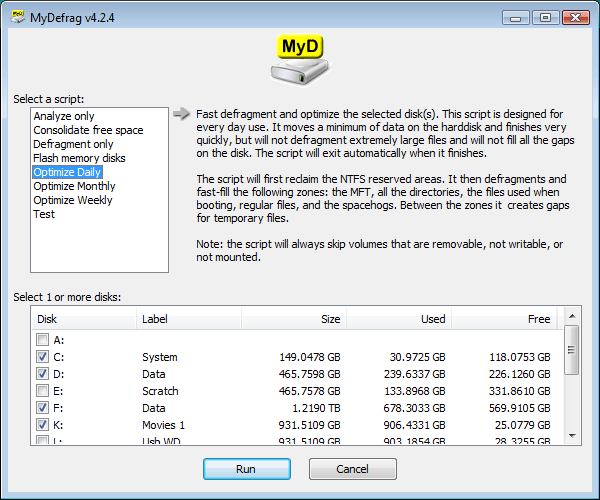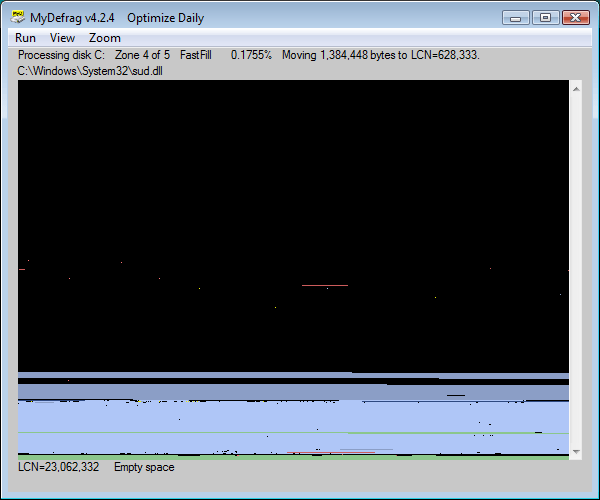|
MyDefrag is extremely solid because it is based on the standard defragmentation API
by Microsoft, a system library that is included in Windows 2000, 2003, XP, Vista,
2008, and Win7. Most defragmenters are based on this API, including the free defragmenter
that comes with Windows and many commercial defragmenters. Basically all MyDefrag
does is send "move this file to that location" commands to the API. The API is
part of the operating system and can safely move almost any file on the disk,
without risk and while the computer is in full use.
- Defragmentation
- Imagine a book split into several parts, some pages are over here, other pages
in another room on another floor altogether. You will have to walk a lot when you
need to read the book. It may sound silly, but this is exactly what happens to
files on your harddisk. Defragmentation will put all the parts (fragments) back
together, making your computer a lot faster.
- Optimization
- Imagine a big library with lots of books, spread out all over the building and
not sorted whatsoever. There is an index telling you exactly where every book is,
but you will have to walk a lot when you need several books. This is exactly what
happens on your harddisk, the files that belong to an application can be all over
the place, anywhere on the harddisk. Optimization will bring all the files together
in one place, leaving the rest of the harddisk empty, and will sort the files, for
example alphabetically.
Defragmentation and optimization will not only make a harddisk faster, but also
lengthen it's life span, because the disk will have less work to do and therefore have
less wear and tear. Also, it will refresh and strengthen the magnetic data on the
harddisk by simply reading the (weakened) data and writing it afresh.
However, defragmenting and optimizing is work, so excessive defragmenting and
optimizing can actually cause more wear and tear than it prevents.
- On most harddisks the beginning of the harddisk is considerably faster than the
end, sometimes by as much as 200 percent! You can measure this yourself with
utilities such as
 HD Tune.
MyDefrag is therefore geared towards moving all files to the beginning of the
disk. HD Tune.
MyDefrag is therefore geared towards moving all files to the beginning of the
disk.
- MyDefrag organizes files into zones, such as directories, Windows files, files
used while booting, regular files, and rarely used files. The most accessed files
are placed at the beginning of the harddisk, and files that are commonly used
together are placed in close proximity to each other. This results in a dramatic
speed increase, and is in fact more important than defragmentation. The program
comes with scripts with a zone organization suitable for most users, power
users can customize the zones through scripts.
- Sorting the files on your disk can give you even more speed. There are several
sorting strategies to choose from. Most of them will take a lot of data shuffling,
taking a lot of time for MyDefrag to complete, and therefore should only be used
occasionally.
- A running computer will create and delete temporary files like there is no
tomorrow. If the harddisk were completely optimized then the only place for
new temporary files would be behind all the other data. Which is rather slow.
MyDefrag can maintain free spaces at various locations on the disk to make temporary
files faster.
- Windows reserves a percentage on NTFS disks for the MFT (Master File Table),
but can place normal files there if the rest of the disk is full.
The files will remain there, even when there is enough space again.
MyDefrag can look for files in the NTFS reserved areas and move them to
normal diskspace, making the reserved areas available again for the MFT.
|
For MyDefrag reviews see:








|
|











